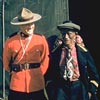Dogrib
 The Dogrib People and their language are unique in that they can only by found in the area designated as the Northwest Territories, the same homelands occupied by their distant ancestors. The Dogrib language is not spoken anywhere else in Canada, and it is the strongest Dene dialect in the Northwest Territories. The Dogrib traditional territory was centred around rivers and lakes around the northern Great Slave Lake area of the Northwest Territories. This area was part of a larger reserve north of Great Slave Lake that was defined at the signing of Treaty 11 with the Federal Government on June 27, 1921. In their traditional lands, the Dogrib once lived a nomadic hunting lifestyle centred around the caribou hunt, living in teepees in the warmer months, and in rectangular huts made of wooden poles and boughs in the winter. Wood was crucial to the Dogrib, and so they tended to keep to the wooded regions of the Northwest Territories, venturing out into the Barren Lands to hunt caribou. This traditional hunting lifestyle gradually shifted to more settled community living over time.
The Dogrib People and their language are unique in that they can only by found in the area designated as the Northwest Territories, the same homelands occupied by their distant ancestors. The Dogrib language is not spoken anywhere else in Canada, and it is the strongest Dene dialect in the Northwest Territories. The Dogrib traditional territory was centred around rivers and lakes around the northern Great Slave Lake area of the Northwest Territories. This area was part of a larger reserve north of Great Slave Lake that was defined at the signing of Treaty 11 with the Federal Government on June 27, 1921. In their traditional lands, the Dogrib once lived a nomadic hunting lifestyle centred around the caribou hunt, living in teepees in the warmer months, and in rectangular huts made of wooden poles and boughs in the winter. Wood was crucial to the Dogrib, and so they tended to keep to the wooded regions of the Northwest Territories, venturing out into the Barren Lands to hunt caribou. This traditional hunting lifestyle gradually shifted to more settled community living over time.
Dogrib spirituality focused on local spirits that inhabited various water bodies, such as lakes. Trust was placed in spirits, who were believed to guide a person through dreams. Medicine men also played a prominent role in Dogrib belief and spirituality. Traditional belief also held that wolves were the spirits of deceased ancestors and, as such, hunting wolves was forbidden in Dogrib culture.
 As
of 2005, there were approximately 3,000 Dogrib living in four communities in the north Slave region: Rae-Edzo (Behcho Ko), Lac La Martre (Wha Ti), Rae lakes (Gameti), and Snare Lake (Wekweti). Negotiations with the Federal Government were underway at that time to finalize a comprehensive land claims agreement that would recognize Dogrib self-government in a defined area of the north Slave region of the Northwest Territories.
As
of 2005, there were approximately 3,000 Dogrib living in four communities in the north Slave region: Rae-Edzo (Behcho Ko), Lac La Martre (Wha Ti), Rae lakes (Gameti), and Snare Lake (Wekweti). Negotiations with the Federal Government were underway at that time to finalize a comprehensive land claims agreement that would recognize Dogrib self-government in a defined area of the north Slave region of the Northwest Territories.





